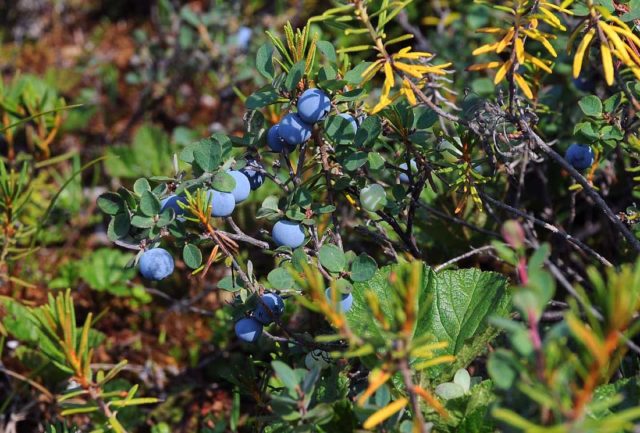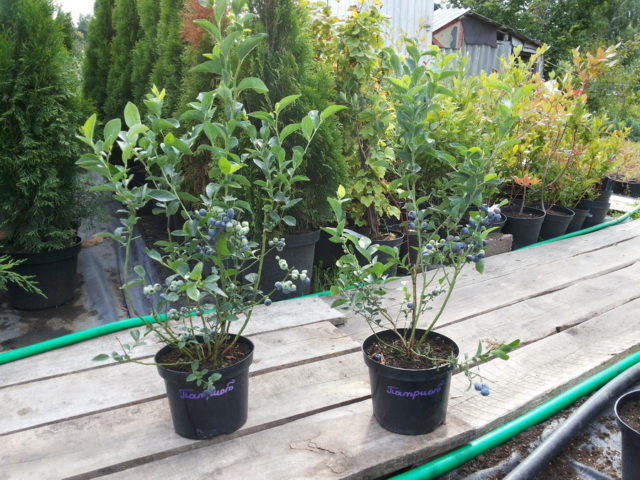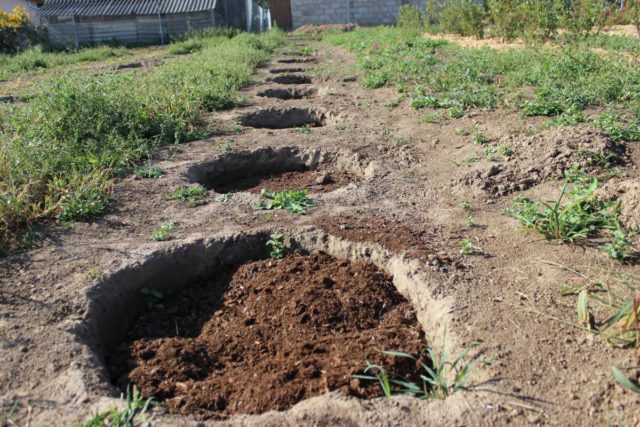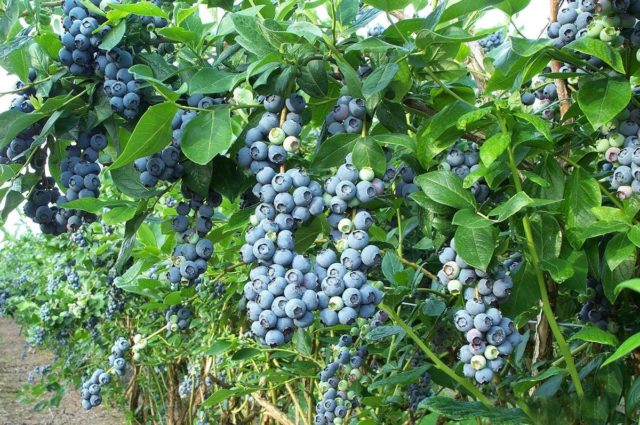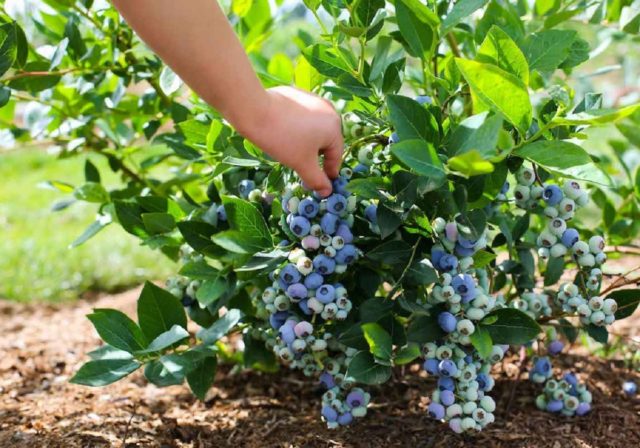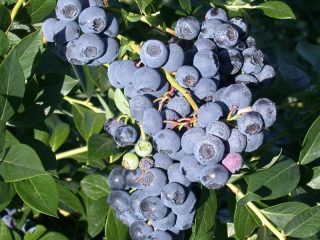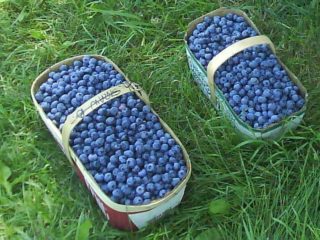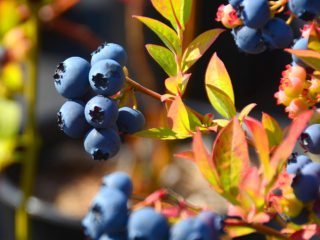Content
Blueberries are a fairly new crop for Russia, which is still gaining popularity. The plant tolerates the conditions of the middle zone well, produces a stable harvest and does not freeze in winter. Proper planting and care of blueberries in the Moscow region will allow you to regularly harvest tasty and healthy berries.
Features of growing blueberries in the Moscow region
The climate of the Moscow region is perfect for growing blueberries. This crop is unpretentious to weather conditions and is rarely affected by diseases and pests. The plant tolerates close proximity to groundwater at a depth of 30 - 60 cm.
In the Moscow region, berries have time to ripen even in cold and rainy summer conditions. Most varieties are characterized by high winter hardiness. Some hybrids do not freeze when the temperature drops to -35 °C.Plants tolerate winters without problems under a light cover of leaves or peat.
To grow blueberries in the Moscow region, it is necessary to ensure high soil acidity. The plant develops at a pH of 3.5 to 5. It is measured using special instruments.
In the Moscow region, soddy-podzolic and gray forest soils predominate. They are characterized by low acidity, but a fairly high humus content. Before planting blueberries, acidifiers must be added to such soil.
Swampy soils in the Moscow region are low-lying areas in the north and east of the region. They have high acidity, but are not rich in humus and other useful substances. When planting blueberries in swampy areas, be sure to make a drainage layer. In addition, they improve the soil composition through mineral fertilizers.
Where do blueberries grow in the Moscow region?
Under natural conditions, blueberries are found in forests, tundra, and mountainous areas. In the Moscow region it is collected in wetlands. Shrubs grow wild in the Taldom, Shatursky, and Yegoryevsky districts.
The wild form of blueberry is a perennial deciduous shrub up to 1 m high. Its leaves are smooth, alternate, up to 3 cm long, located on short petioles. Berries of various shapes: from round to oblong. Their size does not exceed 1.2 cm. The color is blue, the skin is thin, covered with a bluish coating. The pulp is greenish and watery. The fruit tastes sweet and sour.
Cultural forms can be grown in any area of the Moscow region. Compared to wild blueberries, they produce a higher and higher quality yield. Most varieties bear large and tasty fruits already in the 2nd – 3rd year after planting.
What varieties of blueberries are suitable for the Moscow region?
For cultivation in the Moscow region, medium-sized varieties that ripen in early and middle periods are chosen. These are cold-resistant plants that produce a stable harvest. Examples of early varieties for the Moscow region: Duke, Reka, Northland. Of the mid-season varieties, the hybrids Bluecrop, Patriot, and Toro are suitable for the region.
How to plant blueberries in the Moscow region
When growing blueberries in the Moscow region, planting and care are of great importance. It is important to respect the deadlines and sequence of work. Particular attention is paid to the choice of location and further preparation of the soil. Be sure to measure the acidity of the soil and select the correct substrate for the planting hole.
When to plant garden blueberries in the Moscow region
Two-year-old seedlings are preferred for planting. If the plants are sold with a closed root system, then the work can be carried out during the summer season. This includes the period from early spring to late autumn.
In the Moscow region, spring is considered the best time to plant berry crops. They wait for the snow to melt and the soil to warm up. Usually this is the end of April - beginning of May. When choosing the exact timing for disembarkation, they are guided by weather conditions. If frosts are predicted, it is better to postpone work until it is completed.
Autumn planting of blueberries in the Moscow region is allowed. The work is carried out 2–3 weeks before the onset of cold weather. If the planting time has already passed, then the seedling is buried in the ground and sprinkled with sawdust. In spring, the plant is removed from the soil and planting work begins.
Site selection and soil preparation
According to reviews from gardeners, planting and caring for blueberries in the Moscow region does not take much time if you follow the basic rules.Blueberries develop best in sunny areas. In the shade, the bush grows worse, and the berries gain little sugar. The optimal level of groundwater is from 40 to 60 cm. Before planting, the acidity level of the soil is analyzed. An indicator of favorable conditions is the active growth of sorrel, mint, and horsetail. An indicator or laboratory tests will show more accurate results.
If at a site in the Moscow region the soil reaction is neutral or alkaline, then its composition needs to be adjusted. To fill the planting hole, use acidic peat, wood chips or the top layer of soil from the spruce forest. Rotted sawdust is also used as a substrate.
A good option for acidifying the soil is to use powdered sulfur. A year before planting, the soil is dug up and 250 g of this fertilizer is added per 1 m3. Instead of sulfur, use 20 g of ammonium sulfate or ammonium nitrate per 1 square meter. m. Such fertilizers saturate the soil with nitrogen and acidify it well.
Planting blueberries in the Moscow region
To grow blueberries at your dacha in the Moscow region, it is important to carry out the planting work correctly. A hole is dug at the site and filled with prepared substrate. Plants are planted in groups or rows. If there are a lot of seedlings, then it is better to immediately dig a trench.
The procedure for planting blueberries in the Moscow region:
- A hole with a diameter of 1 m to a depth of 0.5 cm is dug in the area.
- If the soil is clayey or not loose enough, then make a drainage layer. To do this, broken brick or small crushed stone is placed at the bottom.
- The walls of the pit are insulated with sheets of iron or polyethylene.
- A substrate consisting of equal amounts of sand and peat is poured into the pit.A little pine needles, sawdust or sulfur are also added to it.
- A ridge is formed above the hole, on which the seedling is placed.
- The roots of the bush are covered and watered abundantly.
- The tree trunk circle is mulched with peat, sawdust or pine needles.
In garden plots in the Moscow region, it is convenient to grow blueberries in containers. The bush is planted in a wooden box or ceramic pot. The plant will decorate the veranda, loggia or terrace. The containers are filled with peat, and drainage is first poured onto the bottom. If the bush grows in containers, then for the winter it is put away in a basement or cellar.
How to grow blueberries in the Moscow region
According to reviews, blueberries in the Moscow region respond positively to care. Plants are provided with watering, fertilizing, and bush formation.
The culture prefers moderate watering. During the growing season, the soil is kept moist. However, take into account that prolonged stagnation of moisture will lead to the death of the plant. For irrigation, take warm, settled water. It is applied under the bush, avoiding contact with leaves and shoots. In the Moscow region, it is enough to water it 1-2 times a week, taking into account precipitation.
When choosing fertilizers, they are guided by the pH level of the soil. The first sign that it needs to be acidified is the redness of the leaves. If measures are not taken, white spots will appear on them, the plant will stop developing and will not bear fruit.
Options for feeding blueberries in the Moscow region:
- 10 g of urea or 20 g of ammonium sulfate per bucket of water;
- 10 g of potassium sulfate or Nitroammofoska per 10 liters of water;
- 10 ml of liquid for car batteries per 10 liters of water;
- 50 g of sulfur powder per bush;
- 3 tsp. citric acid into a large bucket of water;
- any mineral complex for blueberries or rhododendrons.
In the spring, nitrogen fertilizers are applied to blueberries in the Moscow region: urea, ammonium sulfate, Nitroammofoska. During flowering and fruiting, they switch to potassium and phosphorus fertilizers. It is convenient to use special mineral complexes Florovit, Good Power, etc.
Caring for blueberries in the Moscow region also includes sanitary pruning. Due to the formation, the bush does not grow and gives a good harvest. In the third year after planting, no more than 5 powerful shoots are selected. The rest of the shoots are cut out at the root. Broken and dry branches are removed annually. In adult plants, old shoots that no longer bear fruit are pruned.
For the winter in the Moscow region, blueberries are hilled up and peat or humus is poured into the tree trunk. To cover young plants, a frame is built and a non-woven fabric is attached to it. In the spring the structure is removed.
When do blueberries ripen in the Moscow region?
In the Moscow region, the first blueberries ripen in mid-summer. Usually the crop is harvested in 2 - 3 doses. Most of the fruits are ready for harvesting in the first wave of fruiting. They are large in size. The remaining berries are harvested as they ripen over the next 2 to 3 weeks.
The timing of crop ripening in the Moscow region depends on the variety. Early hybrids produce a harvest from the second ten days of July. Medium-bearing varieties are ready for harvest in early August. Late blueberries ripen from the second ten days of August.
Pests and diseases
Agricultural technology for garden blueberries in the Moscow region includes protection from diseases and pests. The culture has high immunity and is rarely damaged. Diseases and insects spread when plantings are dense and humidity is high. Therefore, special attention is paid to bush formation and watering.
In the rainy summer in the Moscow region, blueberries show signs of fungal diseases: gray rot, spotting, moniliosis. They are detected by dark spots on the leaves, fruits and shoots that dry out ahead of time. Affected bushes are treated with Topaz or Hom. Affected plant parts are removed and burned.
The most dangerous pests for blueberries in the Moscow region are caterpillars, leaf rollers, scale insects, and aphids. Insecticides Actellik, Karbofos, etc. are effective against them. For prevention, bushes are dusted with tobacco dust or ash.
Conclusion
Planting and caring for blueberries in the Moscow region will allow you to grow a healthy bush and reap high yields. A separate area is prepared for the crop; peat or other components are required to acidify the soil. During the growing season, blueberries are provided with care: watered, fed, and prevented from pests.
